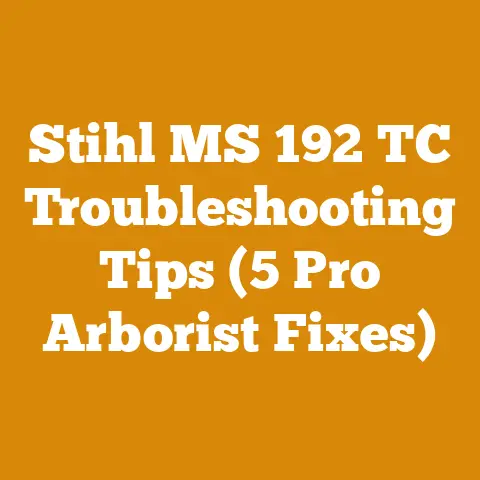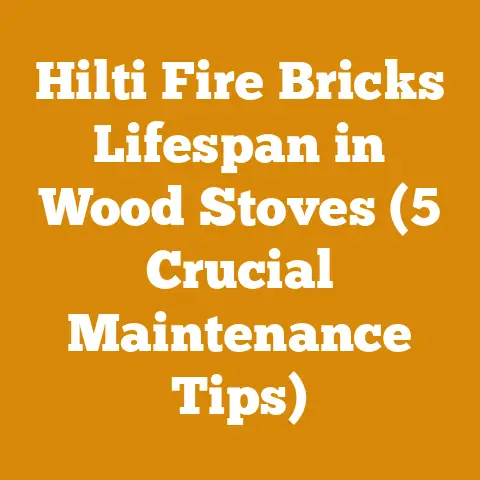Morso Wood Burning Stoves (5 Expert Tips for Optimal Use)
“Winter is coming,” Ned Stark famously warned.
And as any homeowner with a Morso wood-burning stove knows, winter’s chill is best kept at bay with a roaring fire.
But simply tossing logs into your stove isn’t enough.
I’ve learned over years spent splitting wood, stacking cords, and coaxing the perfect flame, that mastering a Morso stove is an art and a science.
It demands understanding the nuances of wood, the mechanics of airflow, and the subtle dance between fuel and fire.
So, gather ’round the virtual hearth, because I’m about to share five expert tips that will unlock the true potential of your Morso wood-burning stove, transforming it from a simple heater into a centerpiece of warmth and efficiency.
5 Expert Tips for Optimal Use of Your Morso Wood Burning Stove
1. Mastering the Art of Wood Selection: Beyond Just “Dry”
Choosing the right wood is the bedrock of efficient wood burning.
It’s not just about whether the wood is dry; it’s about understanding the wood’s density, species, and how it all impacts your stove’s performance.
I remember one particularly harsh winter in the Adirondacks, I was struggling to keep my cabin warm with a load of what I thought was seasoned wood.
Turns out, it was mostly poplar, a softwood that burned quickly and produced little heat.
That’s when I learned the hard way about the importance of wood selection.
Hardwood vs. Softwood: The Heat Value Showdown
Hardwoods, like oak, maple, beech, and ash, are your heavy hitters.
They are denser, burn longer, and produce more heat.
Softwoods, such as pine, fir, and spruce, ignite easily and burn quickly, making them ideal for starting fires, but not for sustained heat.
Here’s a quick rundown of common wood types and their relative heat output (BTU per cord):
My Recommendation: Aim for a mix.
Use softwoods for kindling and starting fires, then transition to hardwoods for sustained, efficient burning.
The Moisture Content Imperative: Aim for Goldilocks Dryness
Moisture content is the single most crucial factor affecting wood-burning efficiency.
Wet wood wastes energy boiling off water instead of producing heat, creates excessive smoke (leading to creosote buildup in your chimney, a fire hazard), and burns inefficiently.
Ideal Moisture Content: The sweet spot is between 15% and 20%.
Anything above 25% is problematic, and anything below 12% can burn too quickly.
How to Measure Moisture Content: A wood moisture meter is your best friend.
These inexpensive devices provide accurate readings.
I use a General Tools MMD4E, which cost me around $30, and it has saved me countless headaches.
Drying Time Guidelines: Air-drying is the most common method.
Stack wood properly (elevated off the ground, spaced for airflow, and covered on top) for at least six months, preferably a year or more.
- Softwoods: 6-12 months
- Hardwoods: 12-24 months
Visual Cues: Look for checks (cracks) in the end grain of the logs, and a dull, grayish color.
Properly seasoned wood will also be significantly lighter than green wood.
Technical Note: Kiln-dried wood offers the lowest moisture content (around 6-8%) but is often more expensive.
Log Dimensions: The Right Size Matters
Morso stoves, like all stoves, are designed for specific log sizes.
Overloading the firebox restricts airflow, leading to incomplete combustion and increased smoke.
Using logs that are too small results in frequent refueling.
General Guidelines for Morso Stoves: Consult your stove’s manual for precise recommendations.
However, as a general rule:
- Log Length: Aim for logs that are approximately 2 inches shorter than the firebox depth.
This allows for proper airflow around the logs.
A standard Morso 6140, for instance, has a firebox depth of around 12 inches, so 10-inch logs are ideal. - Log Diameter: 4-6 inches is a good starting point.
Larger logs burn longer, but smaller logs ignite more easily.
My Strategy: I typically split my wood into a variety of sizes to accommodate different stages of the fire.
Smaller pieces for kindling, medium-sized pieces for starting the fire, and larger pieces for sustained burning.
2. Mastering Airflow: The Key to Clean and Efficient Burning
Airflow is the lifeblood of a wood-burning stove.
It controls the rate of combustion, the heat output, and the amount of smoke produced.
Morso stoves are designed with sophisticated air control systems, and understanding how to use them is crucial for optimal performance.
Primary Air vs. Secondary Air: Understanding the Difference
- Primary Air: Enters the firebox from below or through the front of the stove.
It fuels the initial combustion of the wood. - Secondary Air: Introduced into the upper part of the firebox, often through a series of jets or channels.
It burns off the gases and smoke produced during combustion, resulting in a cleaner and more efficient burn.
Many Morso stoves feature a tertiary air system as well, which further enhances combustion efficiency.
My Observation: I’ve noticed that the placement and design of the secondary air inlets vary significantly between different Morso models.
Some models have a fixed secondary air intake, while others have an adjustable system.
Understanding the specific design of your stove is essential for optimizing airflow.
The “Top-Down” Burning Method: A Game Changer
Traditionally, wood stoves are lit from the bottom, with kindling placed underneath the logs.
However, the “top-down” burning method is far more efficient and produces less smoke.
How to Execute the Top-Down Method:
- Place the largest logs at the bottom of the firebox.
- Arrange smaller logs on top, perpendicular to the bottom logs.
- Add kindling and a fire starter on top of the small logs.
- Light the fire from the top.
Why It Works: This method allows the fire to burn downwards, gradually releasing gases from the wood and burning them more completely.
It also preheats the wood below, promoting more efficient combustion.
Data Point: Studies have shown that the top-down method can reduce particulate emissions by up to 50% compared to traditional bottom-up lighting.
Air Control Adjustments: Finding the Sweet Spot
Every fire is different, and the optimal air control settings will vary depending on the wood type, moisture content, and draft conditions.
Experimentation is key.
General Guidelines:
- Starting the Fire: Use maximum primary air to get the fire going quickly.
- Establishing the Fire: Gradually reduce primary air and increase secondary air to promote clean burning.
- Maintaining the Fire: Adjust air controls as needed to maintain a steady flame and consistent heat output.
Troubleshooting:
- Smoky Fire: Increase secondary air.
- Fire Burning Too Quickly: Reduce primary air.
- Fire Going Out: Increase primary air or add more kindling.
Caution: Never completely close the air controls, as this can lead to carbon monoxide buildup.
3. The Importance of Chimney Maintenance: Preventing Creosote Buildup
A clean chimney is a safe chimney.
Creosote, a flammable byproduct of incomplete combustion, accumulates in the chimney and can cause dangerous chimney fires.
Regular chimney inspections and cleaning are essential.
Understanding Creosote Formation: The Science Behind the Scum
Creosote is formed when wood smoke cools and condenses in the chimney.
Factors that contribute to creosote buildup include:
- Burning wet or unseasoned wood.
- Restricting airflow (smoldering fires).
- Cool chimney temperatures.
Creosote Stages:
- Stage 1: Light, fluffy, and easily removed with a chimney brush.
- Stage 2: Hard, tar-like, and more difficult to remove.
- Stage 3: Glazed, shiny, and extremely difficult to remove.
Requires professional cleaning or, in severe cases, chimney replacement.
My Horror Story: I once neglected my chimney cleaning for too long, and I woke up one night to the sound of a roaring fire in my chimney.
The creosote had ignited, and flames were shooting out the top of the chimney.
I was lucky to catch it in time and extinguish it with a fire extinguisher, but it was a terrifying experience.
Chimney Inspection and Cleaning: A DIY Guide (with Caveats)
Inspection Frequency: At least twice a year, ideally before and after the heating season.
Cleaning Frequency: Depends on usage and wood type.
A general guideline is to clean the chimney after burning one to two cords of wood.
DIY Cleaning:
- Gather Your Tools: Chimney brush (correct size for your chimney flue), extension rods, drop cloths, dust mask, safety glasses.
- Protect Your Home: Cover the area around the stove with drop cloths to prevent soot from spreading.
- Access the Chimney: Remove the stovepipe from the stove and seal the opening with a plastic bag and duct tape.
- Brush the Chimney: Insert the chimney brush into the flue and scrub the chimney walls thoroughly.
- Remove the Soot: Remove the brush and extension rods, and vacuum up the soot that has fallen into the firebox.
- Reassemble: Reconnect the stovepipe to the stove, ensuring a tight seal.
Important Considerations:
- Safety First: Wear a dust mask and safety glasses to protect yourself from soot and debris.
- Chimney Type: Different chimney types (masonry, metal) require different cleaning methods.
- Professional Help: If you are uncomfortable cleaning your chimney yourself, hire a certified chimney sweep.
Cost Comparison: DIY chimney cleaning typically costs around $50-$100 for the necessary tools.
Professional chimney cleaning costs between $150 and $300, depending on the complexity of the job.
Preventing Creosote Buildup: Proactive Measures
- Burn Dry Wood: This is the most important factor.
- Burn Hot Fires: Avoid smoldering fires by ensuring adequate airflow.
- Insulate Your Chimney: This helps to keep the chimney warm and prevent condensation.
- Use a Chimney Cap: This prevents rain and snow from entering the chimney, which can contribute to creosote formation.
4. Mastering the Art of Fire Starting: From Kindling to Roaring Flame
Starting a fire in a Morso stove can be a delightful ritual, but it requires a methodical approach.
I’ve seen too many frustrated folks struggling with smoky fires, and it almost always comes down to poor fire-starting technique.
Kindling Selection: The Foundation of a Good Fire
Kindling is small, dry wood that ignites easily and helps to get the fire going.
Ideal Kindling:
- Dry and Thin: Aim for pieces that are no thicker than your thumb.
- Softwoods: Pine, cedar, and birch bark are excellent choices.
- Avoid Damp or Rotten Wood: This will only create smoke and frustration.
My Kindling Hack: I save all the small scraps of wood from my woodworking projects and use them for kindling.
It’s a great way to recycle and ensures that I always have a supply of dry, readily available kindling.
Fire Starters: A Helping Hand
Fire starters can make the fire-starting process much easier, especially in damp conditions.
Types of Fire Starters:
- Commercial Fire Starters: Wax-based starters, fire cubes, and wood wool soaked in wax are all readily available and effective.
- DIY Fire Starters: You can make your own fire starters using dryer lint, cardboard egg cartons, and melted wax.
- Natural Fire Starters: Pine cones dipped in wax or resin are a great natural option.
My Go-To Fire Starter: I prefer to use wood wool soaked in wax.
They are easy to light, burn hot, and are relatively inexpensive.
The Teepee Method: A Classic Approach
The teepee method is a simple and effective way to arrange kindling for starting a fire.
How to Build a Teepee:
- Place a fire starter in the center of the firebox.
- Arrange kindling around the fire starter in a teepee shape, leaving space for airflow.
- Light the fire starter and allow the kindling to catch fire.
- Gradually add larger pieces of wood as the fire grows.
The Log Cabin Method: For Sustained Burning
The log cabin method is ideal for creating a fire that burns for a longer period of time.
How to Build a Log Cabin:
- Place two logs parallel to each other at the bottom of the firebox.
- Place two more logs perpendicular to the first two, forming a square.
- Continue adding logs in this manner, building a log cabin structure.
- Place kindling and a fire starter in the center of the log cabin.
- Light the fire starter and allow the kindling to catch fire.
5. Safety First: Protecting Yourself and Your Home
Wood-burning stoves can be a safe and efficient source of heat, but it’s crucial to take safety precautions to protect yourself and your home.
Carbon Monoxide Detectors: The Silent Killer
Carbon monoxide (CO) is a colorless, odorless gas that can be deadly.
Install CO detectors on every level of your home, especially near sleeping areas.
CO Detector Placement: Follow the manufacturer’s instructions for placement.
Generally, CO detectors should be placed on the ceiling or high on the wall, as CO is lighter than air.
CO Detector Maintenance: Test your CO detectors regularly and replace the batteries at least once a year.
Smoke Detectors: Early Warning System
Smoke detectors provide an early warning of a fire, giving you time to escape safely.
Smoke Detector Placement: Install smoke detectors on every level of your home, inside and outside of sleeping areas.
Smoke Detector Maintenance: Test your smoke detectors regularly and replace the batteries at least once a year.
Fire Extinguishers: Be Prepared
Keep a fire extinguisher readily accessible near your wood-burning stove.
Fire Extinguisher Type: A multi-purpose (ABC) fire extinguisher is suitable for most household fires.
Fire Extinguisher Training: Familiarize yourself with how to use a fire extinguisher before you need it.
Clearance to Combustibles: Maintaining Safe Distances
Maintain adequate clearance between your wood-burning stove and any combustible materials, such as furniture, curtains, and walls.
Clearance Requirements: Consult your stove’s manual and local building codes for specific clearance requirements.
Heat Shields: Use heat shields to reduce the clearance requirements and protect combustible materials.
Example: Many building codes require a minimum of 36 inches of clearance between a wood-burning stove and combustible walls.
A heat shield can reduce this clearance to as little as 12 inches.
Protective Gear: Protecting Yourself While Working with Wood
Working with wood can be dangerous. Always wear appropriate protective gear, including:
- Safety Glasses: Protect your eyes from flying debris.
- Gloves: Protect your hands from splinters and cuts.
- Hearing Protection: Protect your ears from the noise of chainsaws and other power tools.
- Steel-Toed Boots: Protect your feet from falling logs.
Chainsaw Safety: If you are using a chainsaw to cut firewood, take a chainsaw safety course and always follow the manufacturer’s instructions.
My Personal Rule: I never operate a chainsaw without wearing safety glasses, hearing protection, gloves, and steel-toed boots.
It’s a small price to pay for peace of mind.
Regular Stove Inspections: Catching Problems Early
Inspect your wood-burning stove regularly for signs of damage or wear.
Things to Look For:
- Cracks in the firebox or stove body.
- Damaged door seals.
- Loose or missing parts.
- Excessive rust.
Professional Inspections: Have your wood-burning stove professionally inspected by a qualified technician every year.
I encourage you to continue learning, experimenting, and adapting your approach to suit your specific needs and circumstances.
With a little knowledge and practice, you can transform your Morso stove into a reliable, efficient, and enjoyable source of heat for years to come.
Stay warm, and burn safely!






